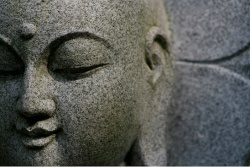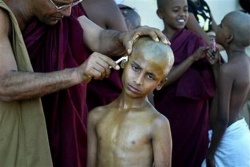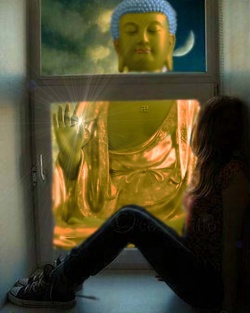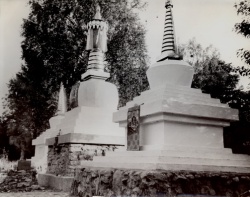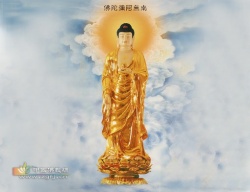Difference between revisions of "The Establishment of the Bhikshuni Order in India"
(Created page with " <poem> Alexander Berzin, August 2007 Buddha himself ordained the first monks simply by reciting the words, “ Ehi bhikkhu (Come here, monk).” W...") |
|||
| Line 1: | Line 1: | ||
| − | + | <nomobile>{{DisplayImages|841|2479|4382|3457|199}}</nomobile> | |
| Line 6: | Line 6: | ||
[[Alexander Berzin]], August 2007 | [[Alexander Berzin]], August 2007 | ||
| − | [[Buddha]] himself [[ordained]] the first [[monks]] simply by reciting the words, “ Ehi [[bhikkhu]] (Come here, [[monk]]).” When a sufficient number of [[monks]] had been [[ordained]] in this manner, he instituted [[ordination]] (bsnyen-par | + | [[Buddha]] himself [[ordained]] the first [[monks]] simply by reciting the words, “ Ehi [[bhikkhu]] (Come here, [[monk]]).” When a sufficient number of [[monks]] had been [[ordained]] in this manner, he instituted [[ordination]] ([[bsnyen-par rdzogs-pa]], Skt. [[upasampada]], [[Pali]]: [[upasampada]]) by the [[bhikshus]] themselves. |
| − | According to many [[traditional]] accounts, [[Buddha]] at first refused, however, when his maternal aunt, [[Mahaprajapati Gautami]] (Go’u-ta-mi sKye-dgu’i bdag-mo chen-mo, Skye-dgu’i bdag-mo, [[Pali]]: [[Mahapajapati Gotami]]), requested him to ordain her as a [[nun]]. | + | According to many [[traditional]] accounts, [[Buddha]] at first refused, however, when his maternal aunt, [[Mahaprajapati Gautami]] ([[Go’u-ta-mi sKye-dgu’i bdag-mo chen-mo, Skye-dgu’i bdag-mo]], [[Pali]]: [[Mahapajapati Gotami]]), requested him to ordain her as a [[nun]]. |
| − | Nevertheless, [[Mahaprajapati]], together with five hundred women followers, shaved their heads, donned [[yellow]] [[robes]], and followed him as [[homeless]] renunciates (rab-tu ‘byung-ba, Skt. [[pravrajita]], [[Pali]]: [[pabbajita]]). | + | Nevertheless, [[Mahaprajapati]], together with five hundred women followers, shaved their heads, donned [[yellow]] [[robes]], and followed him as [[homeless]] renunciates ([[rab-tu ‘byung-ba]], Skt. [[pravrajita]], [[Pali]]: [[pabbajita]]). |
| − | When she asked for [[ordination]] a second and then a third time and was again refused, [[Buddha’s]] [[disciple]] [[Ananda]] (Kun-dga’-bo) interceded on her behalf. | + | When she asked for [[ordination]] a second and then a third time and was again refused, [[Buddha’s]] [[disciple]] [[Ananda]] ([[Kun-dga’-bo]]) interceded on her behalf. |
| − | With this fourth request, [[Buddha]] agreed on the [[condition]] that she and {{Wiki|future}} [[nuns]] observe eight weighty restrictions (lci-ba’i | + | With this fourth request, [[Buddha]] agreed on the [[condition]] that she and {{Wiki|future}} [[nuns]] observe eight weighty restrictions ([[lci-ba’i chos]], Skt. [[gurudharma]], [[Pali]]: [[garudhamma]]). |
| − | These include the seniority rank of [[nuns]] always being lower than that of the [[monks]], regardless of how long the [[monk]] or [[nun | + | These include the seniority rank of [[nuns]] always being lower than that of the [[monks]], regardless of how long the [[monk]] or [[nun vows]] were kept. [[Buddha]] instituted such restrictions in conformity with the {{Wiki|cultural}} values of [[India]] at his time, in order to avoid {{Wiki|disrespect}} by [[society]] for his {{Wiki|community}} and, consequently, for his teachings. |
He also did so to {{Wiki|protect}} the [[nuns]] and ensure them [[respect]] from the [[laypeople]]. In {{Wiki|ancient India}}, women were first under the protection/supervision of their fathers, then their husbands, and finally their sons. | He also did so to {{Wiki|protect}} the [[nuns]] and ensure them [[respect]] from the [[laypeople]]. In {{Wiki|ancient India}}, women were first under the protection/supervision of their fathers, then their husbands, and finally their sons. | ||
| − | Single women were [[thought]] to be {{Wiki|prostitutes}} and there are many cases in the [[Vinaya]] of [[nuns]] being called {{Wiki|prostitutes}} simply because they were not under the [[protection]] of a {{Wiki|male}} [[relative | + | Single women were [[thought]] to be {{Wiki|prostitutes}} and there are many cases in the [[Vinaya]] of [[nuns]] being called {{Wiki|prostitutes}} simply because they were not under the [[protection]] of a {{Wiki|male}} [[relative]]. |
| + | Affiliating the [[bhikshuni sangha]] with the [[bhikshu sangha]] made their single {{Wiki|status}} respectable in the [[eyes]] of [[society]]. | ||
According to some [[traditions]], accepting the [[eight garudhammas]] constituted this first [[ordination]]. | According to some [[traditions]], accepting the [[eight garudhammas]] constituted this first [[ordination]]. | ||
| − | According to other [[traditions]], [[Buddha]] entrusted the initial [[ordination]] of [[Mahaprajapati]] and her five hundred women followers to ten [[bhikshus]], under the [[leadership]] of [[Ananda]]. In either case, the earliest standard method for ordaining [[bhikshunis]] was by a group of ten [[bhikshus]]. | + | According to other [[traditions]], [[Buddha]] entrusted the initial [[ordination]] of [[Mahaprajapati]] and her five hundred women followers to ten [[bhikshus]], under the [[leadership]] of [[Ananda]]. |
| + | |||
| + | In either case, the earliest standard method for ordaining [[bhikshunis]] was by a group of ten [[bhikshus]]. | ||
| − | This manner of [[ordination]] is commonly known as | + | This manner of [[ordination]] is commonly known as “[[single bhikshu sangha ordination]]” ([[pha’i dge-’dun rkyang-pa’i bsnyen-par rdzogs-pa]]). |
| − | The [[ordination]] procedure involves asking the candidates a list of questions concerning impediments (bar-chad-kyi | + | The [[ordination]] procedure involves asking the candidates a list of questions concerning impediments ([[bar-chad-kyi chos]], Skt. [[antarayikadharma]], [[Pali]]: [[antarayikadhamma]]) she may have that might hinder her from keeping the full [[set of vows]]. |
In addition to the questions asked in common with candidates for [[bhikshu ordination]], these include further questions concerning her {{Wiki|anatomy}} as a {{Wiki|female}}. | In addition to the questions asked in common with candidates for [[bhikshu ordination]], these include further questions concerning her {{Wiki|anatomy}} as a {{Wiki|female}}. | ||
| − | When some [[bhikshuni]] candidates expressed extreme discomfort at answering such personal questions to [[monks]], [[Buddha]] instituted the | + | When some [[bhikshuni]] candidates expressed extreme discomfort at answering such personal questions to [[monks]], [[Buddha]] instituted the “[[dual sangha ordination]]” ([[gnyis-tshogs-kyi sgo-nas bsnyen-par rdzogs-pa]]). |
Here, the [[bhikshuni sangha]] first asks the questions regarding the candidate’s suitability to become a [[bhikshuni]]. Later that same day, the [[bhikshuni sangha]] joins with the [[bhikshu sangha]] to [[form]] a joint assembly. | Here, the [[bhikshuni sangha]] first asks the questions regarding the candidate’s suitability to become a [[bhikshuni]]. Later that same day, the [[bhikshuni sangha]] joins with the [[bhikshu sangha]] to [[form]] a joint assembly. | ||
| Line 41: | Line 44: | ||
The [[bhikshu sangha]] gives the [[ordination]], while the [[bhikshuni sangha]] serves as witnesses. | The [[bhikshu sangha]] gives the [[ordination]], while the [[bhikshuni sangha]] serves as witnesses. | ||
| − | At first, the [[vows]] for the [[monastic community]] included avoiding only the | + | At first, the [[vows]] for the [[monastic community]] included avoiding only the “[[naturally uncommendable actions]]” ([[rang-bzhin kha-na-ma-tho-ba]]) – the [[physical]] and [[verbal]] [[actions]] that are {{Wiki|destructive}} for everyone, whether lay or [[ordained]]. |
For [[ordained]] persons, however, these included the [[vow]] of [[celibacy]]. | For [[ordained]] persons, however, these included the [[vow]] of [[celibacy]]. | ||
Revision as of 12:56, 6 November 2015
Alexander Berzin, August 2007
Buddha himself ordained the first monks simply by reciting the words, “ Ehi bhikkhu (Come here, monk).” When a sufficient number of monks had been ordained in this manner, he instituted ordination (bsnyen-par rdzogs-pa, Skt. upasampada, Pali: upasampada) by the bhikshus themselves.
According to many traditional accounts, Buddha at first refused, however, when his maternal aunt, Mahaprajapati Gautami (Go’u-ta-mi sKye-dgu’i bdag-mo chen-mo, Skye-dgu’i bdag-mo, Pali: Mahapajapati Gotami), requested him to ordain her as a nun.
Nevertheless, Mahaprajapati, together with five hundred women followers, shaved their heads, donned yellow robes, and followed him as homeless renunciates (rab-tu ‘byung-ba, Skt. pravrajita, Pali: pabbajita).
When she asked for ordination a second and then a third time and was again refused, Buddha’s disciple Ananda (Kun-dga’-bo) interceded on her behalf.
With this fourth request, Buddha agreed on the condition that she and future nuns observe eight weighty restrictions (lci-ba’i chos, Skt. gurudharma, Pali: garudhamma).
These include the seniority rank of nuns always being lower than that of the monks, regardless of how long the monk or nun vows were kept. Buddha instituted such restrictions in conformity with the cultural values of India at his time, in order to avoid disrespect by society for his community and, consequently, for his teachings.
He also did so to protect the nuns and ensure them respect from the laypeople. In ancient India, women were first under the protection/supervision of their fathers, then their husbands, and finally their sons.
Single women were thought to be prostitutes and there are many cases in the Vinaya of nuns being called prostitutes simply because they were not under the protection of a male relative.
Affiliating the bhikshuni sangha with the bhikshu sangha made their single status respectable in the eyes of society.
According to some traditions, accepting the eight garudhammas constituted this first ordination.
According to other traditions, Buddha entrusted the initial ordination of Mahaprajapati and her five hundred women followers to ten bhikshus, under the leadership of Ananda.
In either case, the earliest standard method for ordaining bhikshunis was by a group of ten bhikshus.
This manner of ordination is commonly known as “single bhikshu sangha ordination” (pha’i dge-’dun rkyang-pa’i bsnyen-par rdzogs-pa).
The ordination procedure involves asking the candidates a list of questions concerning impediments (bar-chad-kyi chos, Skt. antarayikadharma, Pali: antarayikadhamma) she may have that might hinder her from keeping the full set of vows.
In addition to the questions asked in common with candidates for bhikshu ordination, these include further questions concerning her anatomy as a female.
When some bhikshuni candidates expressed extreme discomfort at answering such personal questions to monks, Buddha instituted the “dual sangha ordination” (gnyis-tshogs-kyi sgo-nas bsnyen-par rdzogs-pa).
Here, the bhikshuni sangha first asks the questions regarding the candidate’s suitability to become a bhikshuni. Later that same day, the bhikshuni sangha joins with the bhikshu sangha to form a joint assembly.
The bhikshu sangha gives the ordination, while the bhikshuni sangha serves as witnesses.
At first, the vows for the monastic community included avoiding only the “naturally uncommendable actions” (rang-bzhin kha-na-ma-tho-ba) – the physical and verbal actions that are destructive for everyone, whether lay or ordained.
For ordained persons, however, these included the vow of celibacy.
As time passed, Buddha promulgated an increasing number of additional vows, regarding “ prohibited uncommendable actions” (bcas-pa’i kha-na ma-tho-ba) – physical and verbal actions that are not naturally destructive,
but are prohibited only for ordained persons in order to avoid disrespect by society for the Buddhist monastic community and Buddha’s teachings.
Only Buddha has had the authority to promulgate such prohibitions.
The nuns received more additional vows than did the monks, because each additional vow was established after a specific incident involving the improper behavior of a monk or nun.
The nuns’ vows include those established based on improper behavior of nuns in their interaction with monks, while the monks’ vows do not include reciprocal stipulations.
